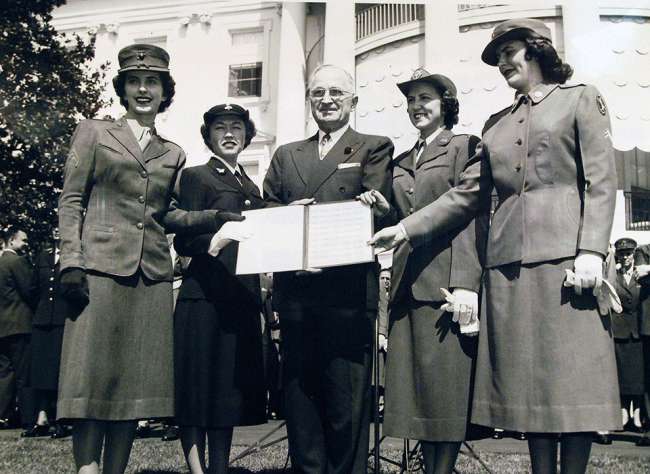Top Image: Readying a horse and parade float from the Royal Burger’s Zoo in 1946. Located in Arnhem in the Netherlands (near the now-infamous “bridge too far”), the Burger’s Zoo suffered significant damage in the waning days of World War II. Image courtesy of the Royal Burger’s Zoo.
In November 1947, roughly two years after the end of World War II in the Pacific, an anonymous reporter for the Associated Press announced a “brave new postwar world” for America’s zoo animals. No longer overshadowed by the “great collections in London, Antwerp, Rotterdam, [and] Berlin,” US zoos were now the “world’s best,” and they were getting better every day. As architects sketched plans for the latest “ultramodern” enclosures, animals from “foreign lands [were] immigrating at a prewar rate,” including between 1,000 and 2,000 monkeys a month. Not even the increasingly chilly Cold War threatened to stem the tide of recent arrivals. Hinting at a future of zoological détente, the reporter gushed:
“Russia’s animals are ready to join the peace loving and vetoless communities of their American furred and feathered comrades. The Soviet government has just sent United States zoos a list of animals it is ready to sell.”
The end of World War II marked an important moment in the political history of modern zoos. Post-war animal shortages offered US zoos an opportunity to perform the role of generous benefactor—the gracious winner of a “good war.” In Great Britain and Western Europe, zoos’ determination to refill their cages coincided with national desires to recover from wartime traumas and reassert their control (symbolically, if not literally) over their dwindling colonies. For many zoos, trading animals served as a form of ad hoc cultural diplomacy, a chance to affirm ties with their allies and build bridges with their former enemies. In the case of the former Axis nations, moreover, zoos’ struggles to refill their cages echoed larger narratives of postwar rehabilitation and reconciliation.
Above all else, zoos’ efforts to rebuild and restock after World War II were part of a broader project. Its goal: to reassert zoos’ authority over wild animals and to redefine zoos as bastions of preservation in an era of imminent species collapse.
To be sure, it is risky to generalize about any aspect of World War II. As Keith Lowe observes in Savage Continent: Europe in the Aftermath of World War II, what we now call “World War II” was more than a “conflict between the Axis and Allies over territory.” It was a conglomeration of “half a dozen civil wars” fought over race, ideology, nationalism, and religion that continued for “weeks, months, sometimes years” after V-E and V-J Day. A nation’s experience of the war was invariably shaped by a host of factors, including its proximity to the fighting. The fates of individual zoos were no less varied.
Zoos in Great Britain, for example, managed to survive the war relatively unscathed. After enduring bomb raids during the early years of the conflict, the London Zoo stabilized quickly and remained open throughout much of the war. In the occupied nations of Western Europe, zoos’ experiences frequently mirrored those of surrounding populations. Dutch zoos suffered significant damage in 1940 and, once defeated, endured a heavy hand from Nazi occupiers, while their counterparts in Paris and Vichy France had a greater degree of autonomy.
A number of German and Japanese zoos were either bombed into near oblivion or suffered such severe shortages—of food, supplies, medicine, and replacement animals—that they entered the postwar period as mere skeletons of their prewar selves. Meanwhile, some zoos in North America and Australia actually flourished during the war years, their attendance boosted by troops en route to the battlefield.
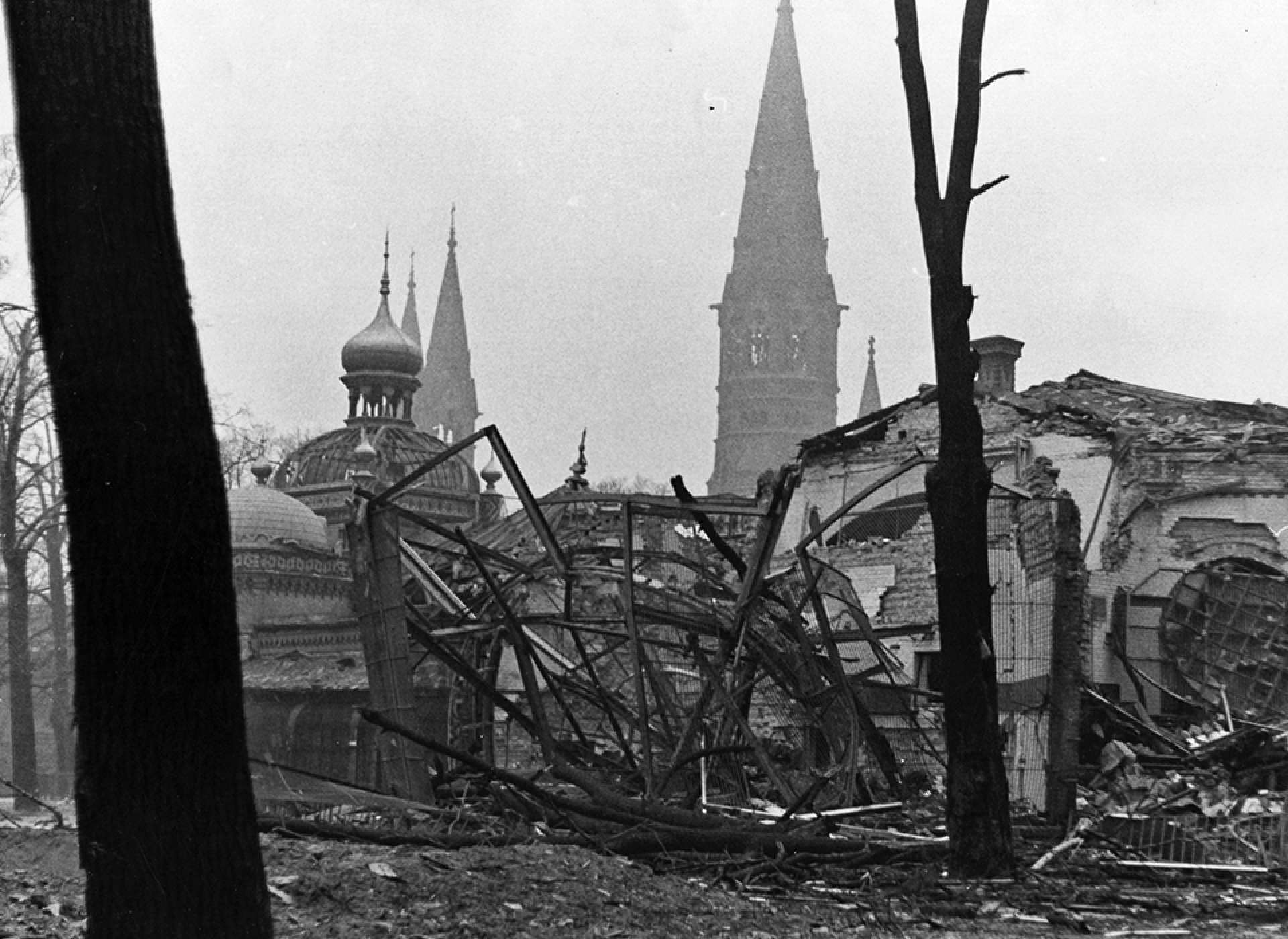
A photo taken by Lutz Heck, Director of the Zoo, of the wreckage of the zoo’s monkey palm house (c. 1943/1944). Image courtesy of Zoolischer Garten Berlin.
Still, the post-war zoo industry faced a number of pressing concerns, starting with a lack of money. Two years after the war’s end, Tokyo’s Ueno Zoo was so broke that it couldn’t afford to feed its few remaining animals, let alone purchase new ones. According to Australian journalist Peggy Warner, who visited Ueno in 1947, most of the animals were barely clinging to life. A pair of black swans paddled listlessly in a “stagnant pool,” and the zoo’s kangaroos were so emaciated that they could barely hop.
The “saddest sight,” in Warner’s eyes, “was a painfully thin black and white cat who lived in the monkey island. The sides of the island [were] too steep….so the cat spen[t] its days in the pit, with two monkeys and a pig.” Visitors were encouraged to bring food from home (one could gain admission with a few stalks of celery), and zoo workers collected hundreds of pounds of potato peels and garbage from SCAP (Supreme Commander for the Allied Powers) kitchens.
The case was similar throughout much of Allied-occupied Germany, where food shortages and disease threatened the surviving population of zoo animals. In the immediate aftermath of Germany’s surrender, some zoos were transformed into makeshift camps for people displaced in the conflict. In 1947, nearly 50 of the most valuable animals from the British Sector were transferred to the London Zoological Society for safekeeping. (They were to be returned three years later).
Zoos of the former Reich were also forced to grapple with the devil’s bargain they had made with Adolf Hitler. Lutz Heck, director of the Berlin Zoo and a close friend of Hermann Göring, fled his post to escape capture. Otto Antonius, director of Vienna’s Schönbrunn Zoo, committed suicide as Soviet forces approached the city. In 1946, the director of the Breslau (now Wroclaw) Zoo was dismissed following the forced expulsion of German citizens in newly reshaped Poland. Thanks to relentless pressure of academics and activities, some German zoos have started to “come clean” about their Nazi pasts, including efforts to “Aryanize” their wartime collections.
Yet, even zoos in victor nations faced major obstacles in their quest to rebuild. In 1945 and 1946, shipping shortages prevented many zoos from importing large stocks of animals from overseas. Because of wartime rationing, zoos still lacked a number of the basic materials—wire mesh, for example—necessary for transporting live animals. No less burdensome were many nations’ strict import regulations, a headache for zoos even in the best of times. Although Australians were, according to one zoo professional, “hungry” for giraffes (there were only two in the country in 1946), the Commonwealth embargoed giraffes, zebras, and antelopes from Africa unless they came from “approved overseas zoos.”
Perhaps the largest problem was the cost of the animals themselves, which spiked due to post-war inflation. “The asking price for giraffes is 100,000 francs, for a two-year-old lion,” Walter Van den bergh, director of the Antwerp Zoo, complained to one of his US colleagues in 1948.
“Only the zoos supported by rich countries can afford to meet such prices. You Americans have spoiled the world market….You have too much money.”
Walter Van den bergh
So, what were zoos to do? One option was to mount an expedition. Since the emergence of the modern zoo in the late eighteenth century, Western zoos had relied on animal-collecting expeditions to Africa, Southeast Asia, and elsewhere to fill their cages with living attractions. In the decade prior to World War II, animal collectors like Frank Buck spun romantic stories about intrepid White adventurers plundering exotic locales for rare and exciting wildlife.
Within the first half-decade of the war’s end, the London Zoological Society sponsored (or directly benefited from) a half dozen animal-collecting expeditions to India, Egypt, the British Cameroons, the Falklands, Ceylon, and other imperial outposts. One zoo employee returned from British Guiana with 28 reptiles and fish, 95 birds, and 57 mammals, including sloths, monkeys, and tapirs. Another left Singapore with a shipment of orangutans, Malay bears, and pythons en route to the British capital. Other European zoos looked to their African and Asian colonies to replenish their decimated collections. Interviewed in 1948, Achille Urbain, director of the Vincennes Zoo in Paris, explained that he was waiting for a large shipment of gorillas, elephants, and monkeys from the French Cameroons. “In one stroke,” Urbain announced, “we shall restore the glories of this zoo.”
The center of much of this collecting fervor was Sub-Saharan Africa, all of which (with the exception of Liberia) remained under European colonial control. In 1946, Bruce Brown, secretary of the Taronga Park Zoo in Sydney, and a companion embarked on a 10,000-mile journey through Rhodesia, Kenya, Uganda, Tanganyika, the Belgian Congo, and South Africa in search of fresh specimens. They returned nine months later with a trained elephant, a beer-drinking chimpanzee, a rhino, six cheetahs, and three lion cubs—all part of the first large consignment of African animals to reach Australia since the war’s end.
Having spent nearly a year in Africa, Brown waxed poetic about the impact of European colonialism on the region:
“There is now no longer ‘a dark continent,’ and the part we once called ‘darkest Africa’ has been traversed by lovely motor roads since the war. It is now quite the usual thing to drive through the country, especially through the animal sanctuaries, and see antelopes and other animals grazing quite near. Lions seem to be the only animals that have never become accustomed to passers-by.”
However, animal collecting expeditions were notoriously costly, both in money and in the large numbers of animals killed in the pursuit of zoo-worthy specimens. More worrying still, zoo professionals feared that the days of extracting the colonial world’s most prized megafauna were nearing an end. As journalist Robert MacMillan noted in 1946, the “political situation in India” combined with a looming famine represent an “awful headache to animal dealers.” Indeed, growing numbers within the zoo industry came to believe that rising tensions across colonial Asia and Africa threatened zoos’ future access to the kinds of animals patrons longed to see.
In addition to colonial plunder, post-war zoos turned to captive breeding programs to repopulate their empty cages. During the war, a number of high-profile zoos made headlines by developing novel techniques for cultivating animal births. In 1944, Nazi propagandists trumpeted the birth of an African elephant at Munich’s Hellabrunn Zoo as a landmark achievement in breeding and “hereditary education.”
By war’s end, many zoo leaders believed that successful breeding programs were central to any effort to protect endangered species. The zoo of the future, noted one British observer hopefully in April 1947, would not be a “mere raree-show, not even only a collection of scientific specimens, but an institution, which, properly handled and developed, may preserve for prosperity much that the world is in grave danger of losing.” Even so, breeding programs had their downsides. Prone to failure, they often took years to develop, and most zoos could only hope to breed a handful of select species.
Thus, any solution to zoos’ post-war challenges would inevitably involve a considerable amount of animal exchange. Zoos had always relied on other zoos to acquire new animal stock and get rid of unwanted or redundant specimens. However, in the aftermath of World War II, such transactions became more important than ever. In 1946, a Chicago newspaper reported, “The reason there are plenty of animals for the public to marvel or shudder at is because of horse-trading among the big zoos.” Across the globe, zoos sent out feelers to their fellow animal collectors in an attempt to buy, exchange, or barter for much-needed attractions. The Antwerp Zoo acquired a pair of ostriches from London in “exchange for two lion cubs.” In late 1949, Sydney’s Taronga Zoo negotiated a deal with the Paris Vincennes zoo for two baby gorillas (worth between £1,400 and £1,500 each). In return, Vincennes received a shipment of rare Australian fauna, which was highly prized by zoos around the globe.
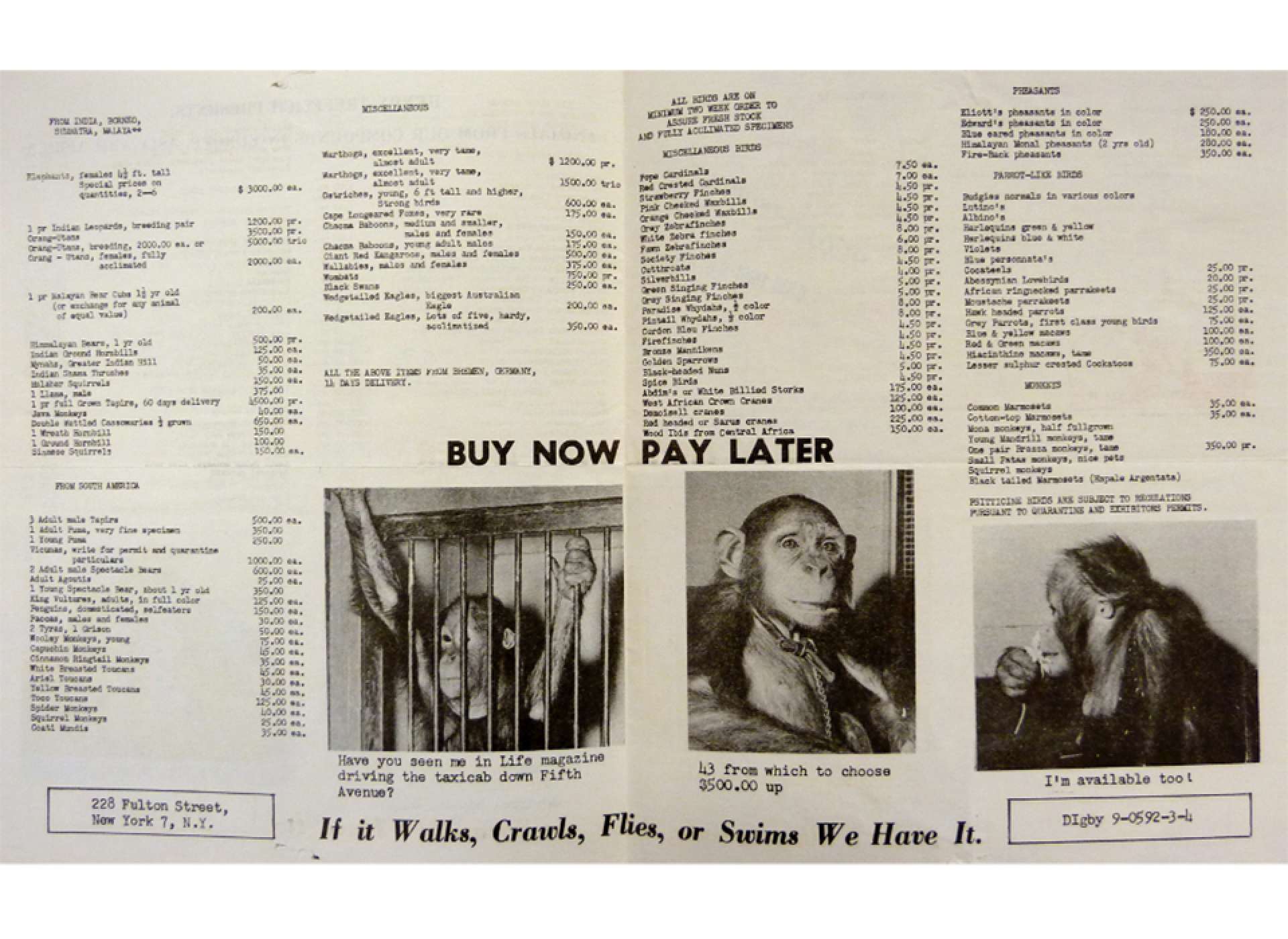
Midcentury animal dealers used brochures like this one to market their wares to zoos around the world. While many dealers focused on specific breeds or geographic locations, this New York-based dealer sold animals from at least three continents under the tagline “If it Walks, Crawls, Flies, or Swims We Have It.” Animals could even be purchased on a finance plan. Image courtesy of Milwaukee Zoo Archives.
Not surprisingly, American zoos assumed an especially public role in helping to restock the war-depleted zoos of Europe and Asia. Like the architects of the American Century, US “zoo men”—and they were primarily men—believed they had a special mission to help their foreign counterparts recover from the war’s devastation. Within a year of the conflict’s end, zoos in the United States sent shipments of animals to former enemies and allies alike, a gesture that went a long way towards confirming the US’ global leadership in post-war zoo circles.
In many cases, such shipments resulted from intimate connections between local communities in the United States and abroad. In May 1948, three-dozen Chicagoans flew to Czechoslovakia to visit family members (most of whom they hadn’t seen in over a decade). Accompanying them on the United Airlines flight were four baby alligators—gifts from the Brookfield Zoo to the Prague Zoological Garden. Likewise, Salt Lake City’s Hogle Zoo was motivated to donate animals to Japan because of a relationship forged with Japanese Americans held at a nearby internment camp during the war years.
American zoos’ motivations weren’t purely altruistic. A number of US zoos instituted what were sometimes called “reverse lend lease” plans with their counterparts overseas. In exchange for animals sent to London, for example, the Philadelphia Zoo received more than 100 birds, mammals, and reptiles. In charge of the floating menagerie was an Army sergeant (and former zoo employee) returning to the United States to be discharged. As the Liberty Ship Russell R. Jones made its 16-day transatlantic passage, First Sergeant Frederick Ulmer was hard at work feeding the animals, tending to their cages, and making sure that none were swept overboard.
The political charge of this kind of zoological diplomacy was rarely far from the surface, particularly at the dawn of the Cold War. Although some zoos exploited United States-Soviet tensions to restock their animal collections, many welcomed opportunities to swap specimens with their Cold War rivals.
Consider the case of the Dmitry Donskoy, which in 1950 became the first Russian ship to visit Sydney, Australia since the war years. It had arrived to pick up a shipment of 5,000 tons of wheat bound for Cairo, though most of the press coverage focused on a gift to the ship’s captain: a small female Queensland wallaby named “Mickey” (after “Mickey Mouse”). Mickey lived in a handmade pouch in the captain’s cabin (directly beneath, it turns out, a portrait of Stalin).
Eventually, the ship captain hoped to acquire a male wallaby as well to give to the Leningrad Zoo, whose lone kangaroo had been killed in bombing raids during the war. Above all else, reporters at the scene highlighted the feelings of cordiality between the shipmaster and his Australian guests. There was “no iron curtain” aboard the Dmitry Donskoy, recalled one local journalist.
"Instead, the captain “toasted the visitors in Russian liqueur, and offered them long, strong Russian cigarettes.”
In the end, World War II’s most important legacy for zoos was a heightened awareness of environmental destruction. Modern zoos had always paid lip service to conservation. But World War II sparked the emergence of an international movement aimed at modernizing the global zoo industry, establishing preservationist-minded breeding networks, and asserting zoos’ authority over increasingly threatened wildlife populations.
Perhaps the most momentous step came in 1946, with the founding of the International Union of Directors of Zoological Gardens (IUDZG) in Rotterdam. Unlike the previous international zoo organization, which disbanded in 1938/39, the IUDZG was dedicated, above all, to preservation. According to its 1947 constitution, all members “resolved to save species from extinction,” a threat that seemed increasingly likely in an age of European genocide and atomic warfare. Initially, zoo directors from Axis nations were forbidden to join, but Tokyo’s Tadamichi Koga was admitted in June 1951, and the IUDZG held its first annual meeting in Germany—previously the center of the zoo world—in 1958.
Over the last seven decades, groups like the IUDZG—now renamed the World Association of Zoos and Aquariums (WAZA)—have continued to promote captive breeding and animal exchange as means of preserving endangered species. For all its best intentions, however, the global zoo industry remains heavily wedded to what scholar Melanie McAlister has called “imperial stewardship,” the notion that the world’s wildlife are “unique cultural assets” to be preserved, protected, and—in more cases than not—placed under Western control.
In his 1944 Annual Report, the President of the New York Zoological Society declared,
“We need to face the unpleasant fact that there are two world-wide wars going on—one, man’s destruction of man; the other, his destruction of the ‘living resources’ of nature, upon which his own existence depends.”
More than 75 years on, the latter fight continues—and we are losing. According to recent studies, anthropogenic climate change could lead to the local extinction of half of the globe’s wildlife species by century’s end. Much like their WWII-era forebears, today’s zoo advocates embrace the idea that zoos—so-called “arks in the park”—represent the best (and perhaps only) hope to preserve some semblance of the world’s zoological diversity.
However, in the battle against the sixth mass extinction, we cannot expect American zoos to take the lead, nor can we depend upon groups like the WAZA to provide all the answers. Instead, we will need to look beyond the zoo to transform humans’ entire relationship with the natural world.
Meet the Author
John M. Kinder is Director of the American Studies Program and Associate Professor of History at Oklahoma State University, where teaches courses on war and society, disability studies, and the history of the body. A historian of war and trauma, he is the author of Paying with Their Bodies: American War and the Problem of the Disabled Veteran (2015), a history of disabled veterans in modern America. He is also the co-editor (with Jason Higgins) of Service Denied: Marginalized Veterans in Modern American History (University of Massachusetts Press, 2022). His current project examines the fate of WWII-era zoos in the United States and beyond.
Further Reading
Bruce, Gary. Through the Lion Gate: A History of the Berlin Zoo (2017)
Itoh, Mayumi. Japanese Wartime Zoo Policy: The Silent Victims of World War (2010)
Kinder, John M. “Militarizing the Menagerie: American Zoos from World War II to the Early Cold War,” in Jimmy L. Bryan, Jr., ed., The Martial Imagination: Cultural Aspects of American Warfare (2013)
Lowe, Keith. Savage Continent: Europe in the Aftermath of World War II (2012)
McAlister, Melanie. Epic Encounters: Culture, Media, and U.S. Interests in the Middle East, 1945-2000 (2001)
Minteer, Ben. A, Jane Mainschein, and James P. Collins. The Ark and Beyond: The Evolution of Zoo and Aquarium Conservation (2018)
Penn, Laura, Markus Gussett, and Gerald Dick. 77 Years: The History and Evolution of the World Association of Zoos and Aquariums, 1935-2012 (2012)
This article is part of a series commemorating the 75th anniversary of the end of World War II made possible by the Department of Defense.
Cite this article:
MLA Citation:
APA Citation:
Chicago Style Citation:
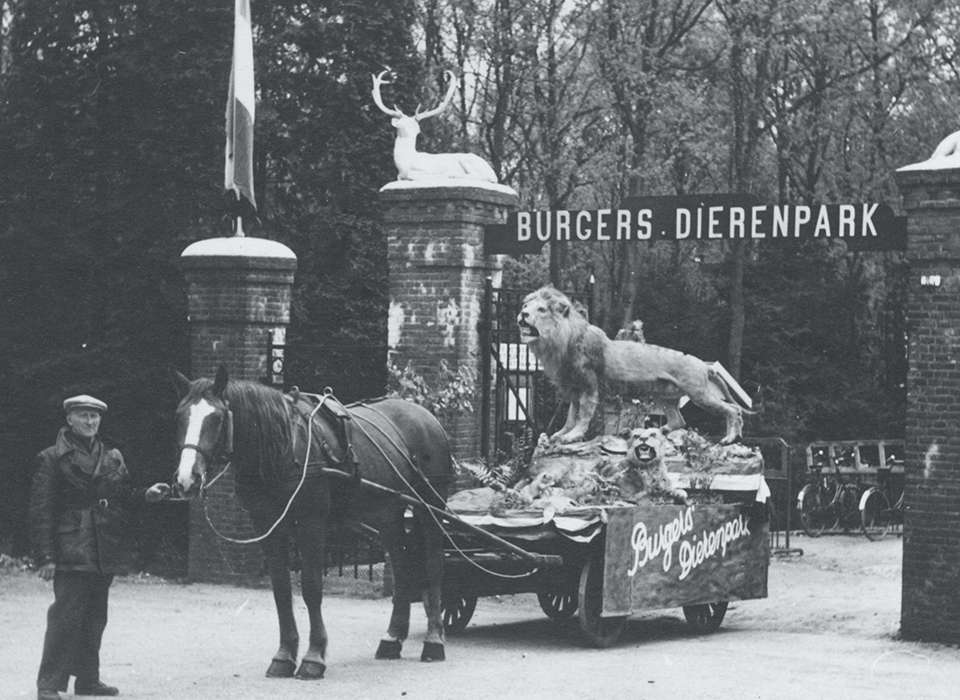

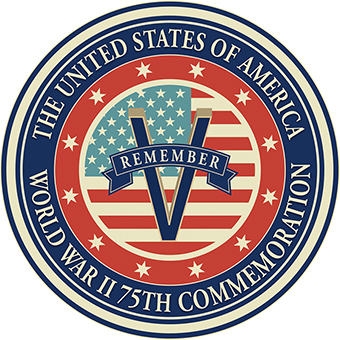

![Max Fuchs, New York City cantor, sings as Rabbi Sydney [sic] Lefkowitz, Richmond, VA, conducts the first Jewish services from Germany.](/sites/default/files/styles/max_650x650/public/2025-10/image1.jpg)


